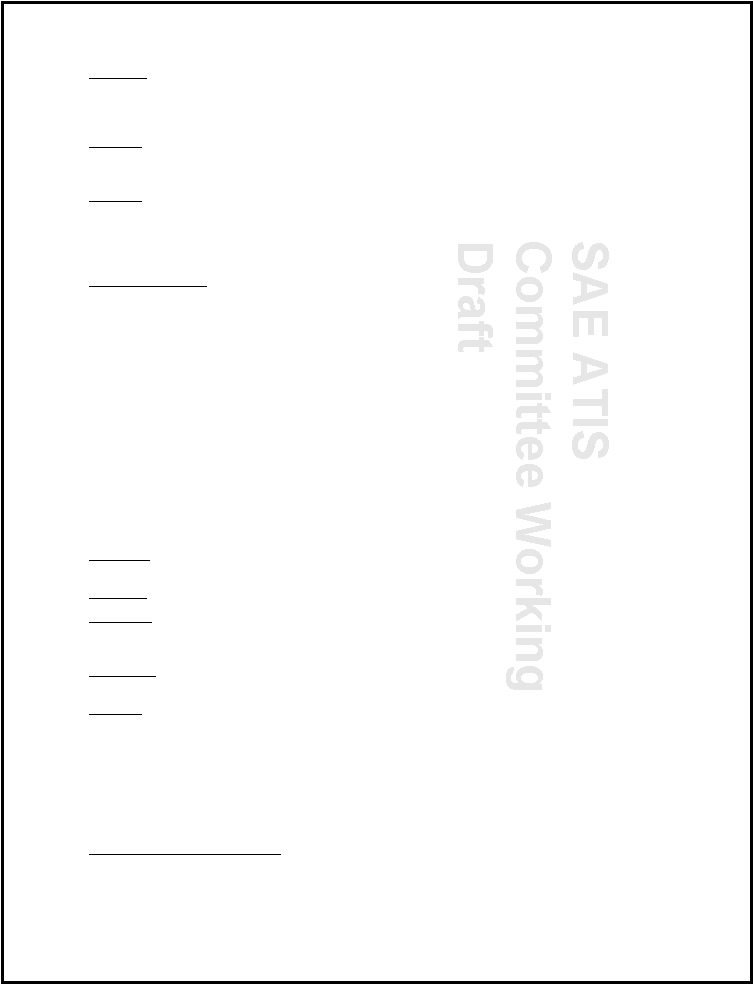
ITIS Phrase Tables, Draft [issued: 04-11-09]
-
11 -
This is a draft document of the SAE ATIS committee, subject to change.
Quantities: Within the message set some specific data elements are provided to hold quantities of
information (for example a data element to be used for the number of injured persons). Implementers
SHALL NOT use the ability of J2540 to add values and units in strings to circumvent the quantities found
in a message set.
Language: Text occurring in the 1512-2000 message is presumed to be of table type #0 if not table type is
denoted. This is a reserved type which implies that the text will be formatted in Latin_1 characters and
employ no indexing (e.g. simple free text).
Local Use: The 1512-2000 allows the standard ITIS phrases to be varied or translated for local applications,
e.g. "traffic stopped" can be expressed as "stationary traffic" if desired. Local additions to the table MAY
still be added as required and SHALL occupy ranges between 129 and 250 in the various tables. This will
be in accordance with the rules of J2540
6
for local list additions, as well as not violating the specifications
of IEEE 1512-2000.
Supporting Messages: Implementers SHOULD also implement the messages of SAE J2540 which support
the automatically downloading, updating and translations of table and table entries to users.
Like all users of these phrases, makers of 1512-2000 message receiving equipment are free to express these
tables in whatever rendering, language, or media formats suit their specific needs.
5.4
Use in the DSRC Message Set
The SAE has developed a set of safety applications messages for use over the DSRC wireless
communication system for exchange between the roadside and between vehicles. These message
definitions can be found in SAE J2735 and its successors. A key aspect of this standard is the use of ITIS
phrase encoding in their 2-byte encoded forms (preferred in this application over XML encoding or phrases
incorporating the use of free text due to bandwidth considerations and other restrictions). These are
typically encoded as octet sequences using the BER-DER encoding method of ASN. One of the
requirements of this effort is the need to be able to encode roadside signage (as defined by the MUTCD
documents) and it for that reason that this edition of the standard contains a number of new categories.
Precedence:
The ASN1 found in the adopted DSRC standard is the definitive authority for DSRC
messages.
Quantities:
The use of qualities and value is allowed in the ITIS expressions.
Textual Use:
The DSRC message definition does not in general allow free text to be used in the
messages, refer to that standard for details. Limited character counts are allowed in selected places to
provide a means to convey street and place names.
Table Types:
The DSRC message definitions presumes that the table entries are static in nature and that
entries are never reused. This is reflected in the table header values outlined further in this document.
Local Use:
DSRC does not allow the standard ITIS phrases to be varied or translated for local
applications contexts, e.g. "traffic stopped" can not be expressed as "stationary traffic" as an alternative.
How each ITIS expression is displayed to an end user (if at all) is not covered by that standard.
6
SAE J2540 provides ways to do this with varying degrees of formality. One can simply pick a
new table number and add whatever is wanted in the least "registered" case, while other ranges of use
provide for national and regional registry control to occur.

